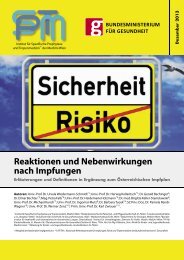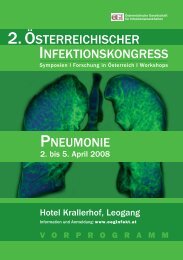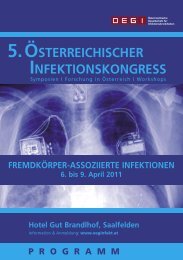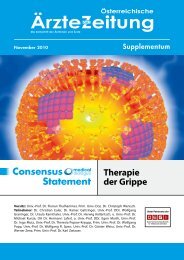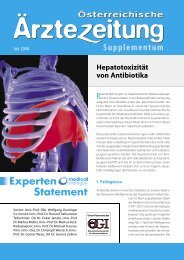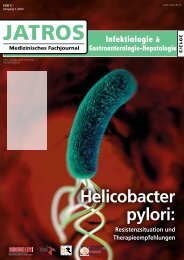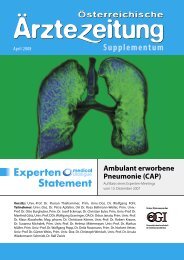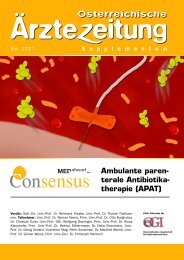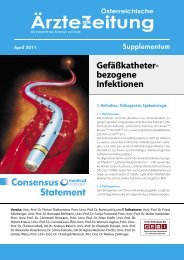Influenza: Aktuelles und State of the Art - Österreichische ...
Influenza: Aktuelles und State of the Art - Österreichische ...
Influenza: Aktuelles und State of the Art - Österreichische ...
Sie wollen auch ein ePaper? Erhöhen Sie die Reichweite Ihrer Titel.
YUMPU macht aus Druck-PDFs automatisch weboptimierte ePaper, die Google liebt.
| kongress<br />
News and innovations<br />
The next wave <strong>of</strong> antimicrobial<br />
approaches and agents<br />
Topics included: antimicrobial photodynamic <strong>the</strong>rapy (PDT); resensitization <strong>of</strong> methicillin-resistant S. aureus<br />
(MRSA); new beta-lactamase inhibitor combinations; new classes <strong>of</strong> tetracyclines; fidaxomicin: a new option<br />
in <strong>the</strong> treatment <strong>of</strong> Clostridium difficile infections (CDIs); antituberculosis drug development: bedaquiline.<br />
Antimicrobial photodynamic<br />
<strong>the</strong>rapy (PDT)<br />
A novel approach to treat drug-resistant<br />
microorganisms is antimicrobial photodynamic<br />
<strong>the</strong>rapy (PDT), which is <strong>und</strong>er<br />
investigation in animal models in <strong>the</strong> lab<br />
<strong>of</strong> Michael R. Hamblin, PhD, Wellman<br />
Center for Photomedicine, Massachusetts<br />
General Hospital Boston, Massachusetts,<br />
USA. PDT involves applying<br />
light from a laser, light-emitting diode,<br />
or o<strong>the</strong>r light source to an infected area<br />
that has been sprayed with a pathogenpenetrating<br />
photosensitizing agent. The<br />
combination <strong>of</strong> photosensitizer and light<br />
results in <strong>the</strong> generation <strong>of</strong> cytotoxic reactive<br />
oxygen species, which kills bacteria<br />
or fungi instantly (Fig. 1). “There has<br />
never been a single pathogen discovered<br />
that is resistant to photodynamic <strong>the</strong>rapy,”<br />
Dr. Hamblin said.<br />
PDT is safe for human tissue, because<br />
<strong>the</strong> photosensitizing agents penetrate<br />
bacteria quickly and take longer to affect<br />
eukaryotic cells. It is inexpensive and<br />
versatile and involves minimal training<br />
for staff and patients. Dr. Hamblin cites<br />
a fur<strong>the</strong>r advantage in treating infections,<br />
such as traumatic infections and<br />
burns, since systemic antibiotics have<br />
trouble reaching damaged tissue. PDT<br />
has a broad <strong>the</strong>rapeutic range, including<br />
viruses and parasites, and can reach pathogens<br />
in bi<strong>of</strong>ilms. In addition, Dr.<br />
Hamblin projects that PDT may be<br />
useful in <strong>the</strong> treatment <strong>of</strong> otitis media,<br />
necrotizing fasciitis, bacterial cystitis,<br />
Antimicrobial photodynamic <strong>the</strong>rapy<br />
Virus<br />
PS<br />
PS: photosyn<strong>the</strong>sizer<br />
IC: inhibitory concentration<br />
F: fluorescence<br />
S<br />
Gram-positive<br />
bacteria<br />
PS<br />
F<br />
IC<br />
Gram-negative<br />
bacteria<br />
gastric H. pylori, sinusitis, or any infection<br />
where dye and light can be infused.<br />
Two hot areas <strong>of</strong> PDT research are: (1)<br />
<strong>the</strong> pursuit <strong>of</strong> ideal photosensitizing<br />
agents, such as bacteriochlorins and porphycenes,<br />
and (2) assessing <strong>the</strong> effects <strong>of</strong><br />
PDT in animal models <strong>of</strong> infection with<br />
bioluminescent organisms. Decreasing<br />
bioluminescence (correlating with decreased<br />
colony-forming units) and improved<br />
survival have been seen in mouse<br />
models <strong>of</strong> burns [Dai et al, Virulence<br />
2001], s<strong>of</strong>t tissue [Gad et al, Photochem<br />
Photobiol Sci 2004], and sepsis across a<br />
range <strong>of</strong> pathogens, including MRSA<br />
[Dai et al, Lasers in Surg and Med<br />
2010], E. coli, Pseudomonas, Acinetobacter<br />
[Dai et al, Antimicrob Agents<br />
Chemo<strong>the</strong>r 2009], S. aureus [Gad et al,<br />
Photochem Photobiol Sci 2004], and<br />
Candida [Dai et al, Antimicrob Agents<br />
Chemo<strong>the</strong>r 2011]. PDT may also stimulate<br />
wo<strong>und</strong> healing.<br />
Scott F. Singleton, PhD, University <strong>of</strong><br />
North Carolina, Chapel Hill, North Carolina,<br />
USA, is leading a team <strong>of</strong> researchers<br />
in <strong>the</strong> development <strong>of</strong> novel antibacterial<br />
adjunct agents that inhibit<br />
bacterial enzymes that are involved in<br />
DNA repair. Their current focus is a<br />
RecA inhibitor to combine with and potentiate<br />
<strong>the</strong> effect <strong>of</strong> DNA-damaging antibiotics.<br />
RecA protein <strong>of</strong> Escherichia<br />
coli and o<strong>the</strong>r anabolic enzymes are up-<br />
Fungus<br />
Parasites<br />
Fig. 1: Mechanisms <strong>of</strong> action <strong>of</strong> antimicrobial photodynamic <strong>the</strong>rapy. Reproduced with permission<br />
PS=photosyn<strong>the</strong>sizer; IC=inhibitory concentration; F=flourescence.<br />
from M. Hamblin, MD<br />
PS<br />
PS<br />
e<br />
O 2<br />
O 2<br />
Type I<br />
Radicals,<br />
OH<br />
Type III<br />
universimed.com<br />
31 I




